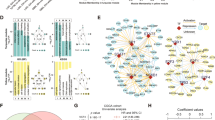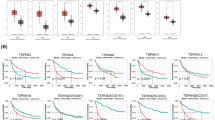Abstract
To identify novel genes associated with pediatric pilocytic astrocytoma (PA) for better understanding the molecular mechanism underlying the pediatric PA pathogenesis. Gene expression profile data of GSE50161 and GSE44971 and the methylation data of GSE44684 were downloaded from Gene Expression Omnibus. The differentially expressed genes (DEGs) between PA and normal control samples were screened using the limma package in R, and then used to construct weighted gene coexpression network (WGCN) using the WGCN analysis (WGCNA) package in R. Significant modules of DEGs were selected using the clustering analysis. Function enrichment analysis of the DEGs in significant modules were performed using the WGCNA package and clusterprofiler package in R. Correlation between methylation sites of DEGs and PA was analyzed using the CpGassoc package in R. Totally, 3479 DEGs were screened in PA samples. Thereinto, 3424 DEGs were used to construct the WGCN. Several significant modules of DEGs were selected based on the WGCN, in which the turquoise module was positively related to PA, whereas blue module was negatively related to PA. DEGs (for example, DOCK2 (dedicator of cytokinesis 2), DOCK8 and FCGR2A (Fc fragment of IgG, low affinity IIa)) in blue module were mainly involved in Fc gamma R-mediated phagocytosis pathway and natural killer cell-mediated cytotoxicity pathway. Methylations of 14 DEGs among the top 30 genes in blue module were related to PA. Our data suggest that DOCK2, DOCK8 and FCGR2A may represent potential therapeutic targets in PA that merits further investigation.
This is a preview of subscription content, access via your institution
Access options
Subscribe to this journal
Receive 12 print issues and online access
$259.00 per year
only $21.58 per issue
Buy this article
- Purchase on Springer Link
- Instant access to full article PDF
Prices may be subject to local taxes which are calculated during checkout




Similar content being viewed by others
References
Dunham C . Pediatric brain tumors: a histologic and genetic update on commonly encountered entities. Semin Diagn Pathol 2010; 27: 147–159.
Dolecek TA, Propp JM, Stroup NE, Kruchko C . CBTRUS statistical report: primary brain and central nervous system tumors diagnosed in the United States in 2005-2009. Neuro Oncol 2012; 14 (Suppl 5): v1–49.
Burkhard C, Di Patre P-L, Schüler D, Schüler G, Yasargil MG, Yonekawa Y et al. A population-based study of the incidence and survival rates in patients with pilocytic astrocytoma. J Neurosurg 2003; 98: 1170–1174.
Saito K, Toda M, Yoshida K . Pilocytic astrocytoma with anaplastic features presenting good long-term clinical course after surgery alone: a case report. Childs Nerv Syst 2014; 7: 7.
Ohgaki H, Kleihues P . Population-based studies on incidence, survival rates, and genetic alterations in astrocytic and oligodendroglial gliomas. J Neuropathol Exp Neurol 2005; 64: 479–489.
Cin H, Meyer C, Herr R, Janzarik WG, Lambert S, Jones DT et al. Oncogenic FAM131B-BRAF fusion resulting from 7q34 deletion comprises an alternative mechanism of MAPK pathway activation in pilocytic astrocytoma. Acta Neuropathol 2011; 121: 763–774.
Hawkins C, Walker E, Mohamed N, Zhang C, Jacob K, Shirinian M et al. BRAF-KIAA1549 fusion predicts better clinical outcome in pediatric low-grade astrocytoma. Clin Cancer Res 2011; 17: 4790–4798.
Jones DT, Kocialkowski S, Liu L, Pearson DM, Backlund LM, Ichimura K et al. Tandem duplication producing a novel oncogenic BRAF fusion gene defines the majority of pilocytic astrocytomas. Cancer Res 2008; 68: 8673–8677.
Lambert SR, Witt H, Hovestadt V, Zucknick M, Kool M, Pearson DM et al. Differential expression and methylation of brain developmental genes define location-specific subsets of pilocytic astrocytoma. Acta Neuropathol 2013; 126: 291–301.
Sharma MK, Watson MA, Lyman M, Perry A, Aldape KD, Deak F et al. Matrilin-2 expression distinguishes clinically relevant subsets of pilocytic astrocytoma. Neurology 2006; 66: 127–130.
Ho CY, Bar E, Giannini C, Marchionni L, Karajannis MA, Zagzag D et al. MicroRNA profiling in pediatric pilocytic astrocytoma reveals biologically relevant targets, including PBX3, NFIB, and METAP2. Neuro Oncol 2013; 15: 69–82.
Jones DT, Gronych J, Lichter P, Witt O, Pfister SM . MAPK pathway activation in pilocytic astrocytoma. Cell Mol Life Sci 2012; 69: 1799–1811.
Bikowska-Opalach B, Szlufik SA, Grajkowska WA, Jozwiak J . Pilocytic astrocytoma: a review of genetic and molecular factors, diagnostic and prognostic markers. Histol Histopathol 2014; 29.
Hutt-Cabezas M, Karajannis MA, Zagzag D, Shah S, Horkayne-Szakaly I, Rushing EJ et al. Activation of mTORC1/mTORC2 signaling in pediatric low-grade glioma and pilocytic astrocytoma reveals mTOR as a therapeutic target. Neuro Oncol 2013; 15: 1604–1614.
Rodriguez EF, Scheithauer BW, Giannini C, Rynearson A, Cen L, Hoesley B et al. PI3K/AKT pathway alterations are associated with clinically aggressive and histologically anaplastic subsets of pilocytic astrocytoma. Acta Neuropathol 2011; 121: 407–420.
Christensen BC, Smith AA, Zheng S, Koestler DC, Houseman EA, Marsit CJ et al. DNA methylation, isocitrate dehydrogenase mutation, and survival in glioma. J Natl Cancer Inst 2011; 103: 143–153.
Lindqvist BM, Wingren S, Motlagh PB, Nilsson TK . Whole genome DNA methylation signature of HER2-positive breast cancer. Epigenetics 2014; 9: 8.
Uhlmann K, Rohde K, Zeller C, Szymas J, Vogel S, Marczinek K et al. Distinct methylation profiles of glioma subtypes. Int J Cancer 2003; 106: 52–59.
Griesinger AM, Birks DK, Donson AM, Amani V, Hoffman LM, Waziri A et al. Characterization of distinct immunophenotypes across pediatric brain tumor types. J Immunol 2013; 191: 4880–4888.
Pruitt KD, Tatusova T, Maglott DR . NCBI reference sequences (RefSeq): a curated non-redundant sequence database of genomes, transcripts and proteins. Nucleic Acids Res 2007; 35 (suppl 1): D61–D65.
Gautier L, Cope L, Bolstad BM, Irizarry RA . Affy–analysis of Affymetrix GeneChip data at the probe level. Bioinformatics 2004; 20: 307–315.
Gentleman R, Carey V, Dudoit S, Irizarry R, Huber W (eds). Bioinformatics and Computational Biology Solutions using R and Bioconductor. Springer: New York, 2005.
Langfelder P, Horvath S . WGCNA: an R package for weighted correlation network analysis. BMC Bioinformatics 2008; 9: 559.
Shannon P, Markiel A, Ozier O, Baliga NS, Wang JT, Ramage D et al. Cytoscape: a software environment for integrated models of biomolecular interaction networks. Genome Res 2003; 13: 2498–2504.
Yu G, Wang LG, Han Y, He QY . ClusterProfiler: an R package for comparing biological themes among gene clusters. OMICS 2012; 16: 284–287.
Barfield RT, Kilaru V, Smith AK, Conneely KN . CpGassoc: an R function for analysis of DNA methylation microarray data. Bioinformatics 2012; 28: 1280–1281.
Lee HJ, Song IC, Yun HJ, Jo DY, Kim S . CXC chemokines and chemokine receptors in gastric cancer: from basic findings towards therapeutic targeting. World J Gastroenterol 2014; 20: 1681–1693.
Wang L, Nishihara H, Kimura T, Kato Y, Tanino M, Nishio M et al. DOCK2 regulates cell proliferation through Rac and ERK activation in B cell lymphoma. Biochem Biophys Res Commun 2010; 395: 111–115.
Huang H, Hara A, Homma T, Yonekawa Y, Ohgaki H . Altered expression of immune defense genes in pilocytic astrocytomas. J Neuropathol Exp Neurol 2005; 64: 891–901.
Uhlmann K, Rohde K, Zeller C, Szymas J, Vogel S, Marczinek K et al. Distinct methylation profiles of glioma subtypes. Int J Cancer 2003; 106: 52–59.
Fonseca AL, Kugelberg J, Starker LF, Scholl U, Choi M, Hellman P et al. Comprehensive DNA methylation analysis of benign and malignant adrenocortical tumors. Genes Chromosomes Cancer 2012; 51: 949–960.
Montaño CM, Irizarry RA, Kaufmann WE, Talbot K, Gur RE, Feinberg AP et al. Measuring cell-type specific differential methylation in human brain tissue. Genome Biol 2013; 14: R94.
Davis JC, Dove CG, Su HC . Genetic, clinical, and laboratory markers for DOCK8 immunodeficiency syndrome. Dis Markers 2010; 29: 131–139.
Takahashi K, Kohno T, Ajima R, Sasaki H, Minna JD, Fujiwara T et al. Homozygous deletion and reduced expression of the DOCK8 gene in human lung cancer. Int J Oncol 2006; 28: 321–328.
Kyogoku C, Tsuchiya N, Matsuta K, Tokunaga K . Studies on the association of Fcγ receptor IIA, IIB, IIIA and IIIB polymorphisms with rheumatoid arthritis in the Japanese: evidence for a genetic interaction between HLA-DRB1 and FCGR3A. Genes Immun 2002; 3: 488–493.
Dornan D, Spleiss O, Yeh RF, Duchateau-Nguyen G, Dufour A, Zhi J et al. Effect of FCGR2A and FCGR3A variants on CLL outcome. Blood 2010; 116: 4212–4222.
Hannani D, Sistigu A, Kepp O, Galluzzi L, Kroemer G, Zitvogel L . Prerequisites for the antitumor vaccine-like effect of chemotherapy and radiotherapy. Cancer J 2011; 17: 351–358.
Mellor JD, Brown MP, Irving HR, Zalcberg JR, Dobrovic A . A critical review of the role of Fc gamma receptor polymorphisms in the response to monoclonal antibodies in cancer. J Hematol Oncol 2013; 6: 1.
Guilliams M, Bruhns P, Saeys Y, Hammad H, Lambrecht BN . The function of Fc [gamma] receptors in dendritic cells and macrophages. Nat Rev Immunol 2014; 14: 94–108.
Roggendorf W, Strupp S, Paulus W . Distribution and characterization of microglia/macrophages in human brain tumors. Acta Neuropathol 1996; 92: 288–293.
Yang I, Han SJ, Sughrue ME, Tihan T, Parsa AT . Immune cell infiltrate differences in pilocytic astrocytoma and glioblastoma: evidence of distinct immunological microenvironments that reflect tumor biology: laboratory investigation. J Neurosurg 2011; 115: 505–511.
Choi KS . Autophagy and cancer. Exp Mol Med 2012; 44: 109–120.
Duthie SJ . Folate and cancer: how DNA damage, repair and methylation impact on colon carcinogenesis. J Inherit Metab Dis 2011; 34: 101–109.
Nakata S, Campos B, Bageritz J, Lorenzo Bermejo J, Becker N, Engel F et al. LGR5 is a marker of poor prognosis in glioblastoma and is required for survival of brain cancer stem‐like cells. Brain Pathol 2013; 23: 60–72.
Rodenhiser DI, Andrews J, Kennette W, Sadikovic B, Mendlowitz A, Tuck AB et al. Epigenetic mapping and functional analysis in a breast cancer metastasis model using whole-genome promoter tiling microarrays. Breast Cancer Res 2008; 10: R62.
Acknowledgements
This work was supported by National Natural Science Foundation grant from China National Science Foundation Committee (project code: 81172410).
Author information
Authors and Affiliations
Corresponding author
Ethics declarations
Competing interests
The authors declare no conflict of interest.
Additional information
Highlights
• Twelve gene coexpression modules in pediatric PA were identified.
• The turquoise module, positively related to PA, was enriched for nerve function.
• The blue module, inversely associated to PA, was mainly involved in immune process.
• Fourteen genes containing methylated sites are related to PA in the blue module.
• DOCK2 and FCGR2A may be potential therapeutic targets as hub genes.
Supplementary Information accompanies the paper on Cancer Gene Therapy website
Supplementary information
Rights and permissions
About this article
Cite this article
Zhao, H., Cai, W., Su, S. et al. Screening genes crucial for pediatric pilocytic astrocytoma using weighted gene coexpression network analysis combined with methylation data analysis. Cancer Gene Ther 21, 448–455 (2014). https://doi.org/10.1038/cgt.2014.49
Received:
Revised:
Accepted:
Published:
Issue Date:
DOI: https://doi.org/10.1038/cgt.2014.49
This article is cited by
-
Disclosing transcriptomics network-based signatures of glioma heterogeneity using sparse methods
BioData Mining (2023)
-
Identification of collagen genes related to immune infiltration and epithelial-mesenchymal transition in glioma
Cancer Cell International (2021)
-
Identification of differentially expressed genes and their upstream regulators in colorectal cancer
Cancer Gene Therapy (2017)
-
Weighted gene co-expression network analysis identifies specific modules and hub genes related to coronary artery disease
BMC Cardiovascular Disorders (2016)
-
Gene co-expression network analysis reveals common system-level properties of genes involved in tuberculosis across independent gene expression studies
Network Modeling Analysis in Health Informatics and Bioinformatics (2016)



